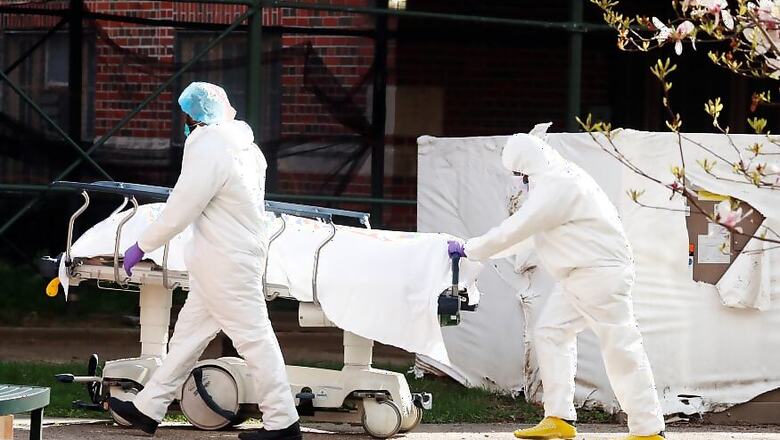
views
The governors of New York, New Jersey and Connecticut on Wednesday ordered travelers from eight other U.S. states to be quarantined for two weeks on arrival, as COVID-19 infections surged in regions spared the brunt of the initial outbreak.
The unprecedented travel restrictions came as Disney announced it would delay the reopening of its theme parks, and Nevada's governor signed a directive requiring face coverings in casinos and all other public places from Friday.
"We must make face coverings a routine part of our daily lives," Governor Steve Sisolak said in announcing the order, citing a four-week upward trend in new Nevada cases of COVID-19, the illness caused by the novel coronavirus.
"It's a medical necessity, a human obligation and it's good business," Sisolak, a Democrat, added. The directive expands a requirement already in place for business owners and their employees to members of the public at large.
Earlier in the day, New Jersey Governor Phil Murphy said the tough new tri-state quarantine mandate was "the smart thing to do" after the United States as a whole recorded its second-greatest daily increase in COVID-19 cases since early March.
"We have taken our people, the three of us from these three states, through hell and back, and the last thing we need to do right now is subject our folks to another round," Murphy said of the three Northeastern governors, all Democrats.
A White House spokesman, Judd Deere, said that he did not believe the quarantine applied to President Donald Trump, who just returned from a visit to Arizona and was scheduled to be in New Jersey this weekend.
"The president of the United States is not a civilian. Anyone who is in close proximity to him, including staff, guests, and press, are tested for COVID-19 and confirmed to be negative," Deere said.
Concern over rising case numbers in several states was reflected in some of America's biggest entertainment and leisure companies as well.
The Walt Disney Co. said in a statement that it would delay a planned July 17 reopening of its theme parks and resort hotels as it waits for guidelines from the state of California.
MGM Resorts International announced that all guests to its properties throughout the United States would be required to wear masks, as was already the case for employees.
Nevada was the latest of about a dozen states, including California and Washington state, to adopt face-covering rules.
New York City was the early epicenter of the U.S. coronavirus pandemic. More than 31,000 people have died of COVID-19 in New York state alone, roughly one-quarter of the U.S. total, according to a Reuters tally. New Jersey and Connecticut were also especially hard hit at the outset of the health crisis.
The 14-day quarantine applies to visitors from mostly Southern states: Alabama, Arkansas, Arizona, Florida, North Carolina, South Carolina, Texas and Utah, as well as tri-state residents returning from those areas. The quarantine states are determined by a formula based on the number of new cases.
Those caught defying the quarantine rule face $1,000 fines for a first offense and $5,000 for repeat offenses, New York Governor Andrew Cuomo said.
STATES SET NEW ALL-TIME HIGHS
While the United States appeared to have tamped down the outbreak in May, prompting many states to lift sweeping stay-at-home orders and business closures, testing suggests the virus has moved into rural areas and other places where it was initially less prevalent.
The pandemic may also be resurgent in U.S. states that opened earlier than others in an effort to blunt the devastating economic impact of coronavirus restrictions as unemployment rates shot up.
On Wednesday, three states reported record increases in new cases – Florida, Oklahoma and South Carolina. Earlier in the week, seven states had record highs – Arizona, California, Mississippi, Missouri, Nevada, Texas and Wyoming.
The nationwide surge of nearly 36,000 new cases on Tuesday marked the highest since a record 36,426 new U.S. infections recorded on April 24.
At least four states are averaging double-digit rates of positive tests for the virus. By contrast, New York has been reporting positive test rates of around 1%.
While some of the increased numbers of cases can be attributed to more testing, the percentage of positive results is also climbing.
The average number of tests has risen 7.6% over the last seven days, according to The COVID Tracking Project, while the average number of new cases rose 30%.
(Reporting by Jonathan Allen and Peter Szekely in New York; Additional reporting by Steve Holland Susan Heavey in Washington, Steve Gorman in Los Angeles and Aishwarya Nair and Bhargav Acharya in Bangalore; Writing by Dan Whitcomb; Editing by Lisa Shumaker, Cynthia Osterman and Grant McCool)



















Comments
0 comment